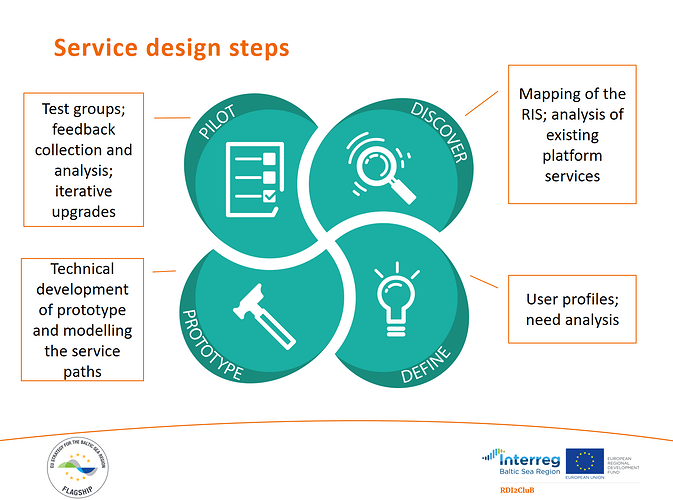DISCOVERY: Mapping of Networks and Platforms
In the Discovery stage of our service design path, we carried out a state-of-art service analysis on 26 networks and platforms. This multi-step process gave us insights on the best practices as well as the mistakes to avoid. It also helped us to position ourselves in the framework of European bioeconomy and innovation networks and platforms.
In the end the process took more than 6 months, but it was very valuable learning experience to help the Biobord developers understand what adds value to the user experience and what are the needs and expectations of the connected hubs in relation to platform development.
As some of the main conclusion, we propose the following notions: the platform has to make your work easier – not create more work; human connection is important; connecting different networks together adds value.
These have been one of the guiding principles in design, however, they is also something that could always be improved upon in the upgrades of the Biobord platform and especially the operating model.
Materials and steps of the process are outlined below. Stay tuned for next week, when we introduce the mapping of RIS.
Overview of Mapping of Networks and Platforms
We started with a ‘Pre-screening’ of the 26 networks and platforms completed in August 2018.
The pre-screening material includes data on transnational platforms for networking of clusters and/or Regional Innovation Systems (5), innovation service platforms for SMEs (3), Bioeconomy RDI platforms or networks with relevance to BSR/EU (5), Bioeconomy RDI platforms or networks created in past Interreg projects (2) and Bioeconomy RDI platforms or networks created in Horizon2020 projects (11). Short descriptions of the networks and platforms including examples of the platform model or service were collected of 26 networks and platforms. Along with the short descriptions, the pre-screening material involves two Excel documents containing the raw data.
30.08.2018_Mapping_networks_platforms_pre-screening_results_RDI2CluB.pdf (336.7 KB)
Annex1_Basic_data_3.2.3.xlsx (82.6 KB)
Annex2_Innovationservices_3.2.3.xlsx (71.1 KB)
In the next phase, we carried out analysis of the lessons learned and recommendations for our platform development.
The pre-screening data was reviewed by the regional innovation hubs involved in the RDI2CluB – Bioeconomy Campus in Central Finland, Evenstad Innovation Centre in Hedmark (Norway), Bioeconomy Knowledge Centre in Świętokrzyskie Voivodeship (Poland) and High added value and healthy food cluster in Vidzeme (Latvia). The hubs responded to a survey to highlight their interests in platform development, to identify interesting network and platform services and to map the national and regional platforms focusing on bioeconomy.
Based on the survey responses, JAMK University of Applied Sciences compiled an analysis report on lessons learned and recommendations for partnership in November 2018.
Analysis_screeningsurvey_results_28112018_Annexesincluded.pdf (1.2 MB)
Lessons for the RDI2CluB platform development
-
The use of online platforms on national and regional levels is more common in Finland and Norway compared to Poland and Latvia. This should be taken into consideration when planning the uptake.
-
The SMEs and other user groups should be analyzed separately, as the responses of the hubs may not adequately reflect the needs of the SMEs.
-
Many platform features are not visible for un-registered users, which hinders evaluation. Test-use of existing knowledge bases would be recommendable.
-
All in all, we have a wide variety of knowledge base ideas; the focus areas should be specified in the Joint Action Plans and we should aim to utilise and complement existing knowledge bases wherever possible.
For the innovation hubs as a user group of a platform, the following features are seen to add value:
-
Networking and matchmaking for attainment of EU funding and gaining access to international RDI co-operation projects;
-
Knowledge base on the updated EU/European bioeconomy context;
-
Connections to the networks and platforms run or supported by the EU commission is seen to add credibility and visibility in EU context;
-
Good search features on databases and networks;
-
Communication material on bioeconomy for public awareness-raising; and
-
Tools and means to communicate the impact of the hub’s projects and RDI activities for a wider multiplying effect and impact to society.
Recommendations on Transnational learning and experience sharing
Recommendations for next steps in the regional innovation hubs are outlined here to be discussed in more details in the ‘Innovation Hub Developers’ group.
As certain partners are already involved in the networks and platforms included in the prescreening, there are also opportunities for transnational learning between the partners. Based on the responses, we can match the partners interested in certain networks and platforms with partners already involved in them.
Transnational learning opportunities identified include:
-
To learn more on ECCP, PL is recommended to discuss with LV who is involved in ECCP
-
To learn more on S3 platform, FI and NO are recommended to discuss with PL who is involved in S3 platform
-
To learn more on EIT Climate KIC, FI and NO are recommended to discuss with LV who is involved in EIT Climate KIC; FI, NO and LV could also study the EIT Food KIC in more detail.
-
To learn more on ERRIN, LV is recommended to discuss with the Regional Council of Central Finland who is involved in ERRIN
Networks and platforms ranked most relevant for the partner hubs:
-
EIP-Agri was found relevant by all hubs
-
EIT Climate KIC was found relevant by FI and NO; LV is already involved, but would also be interested in EIT Food KIC
-
S3 platform was found relevant by FI and NO; PL is already involved
It was recommended that the interested hubs would pursuit involvement in the relevant networks jointly as a part of the joint action plans.
As a final step, a group of Biobord developers agreed to take part in a test-use of selected platforms for benchmarking.
As per the assignment, the test-use time should be few weeks, preferably up to one month. This means that the test user should register to the platform and try-out the service for one month in order to explore the networking impact as well as the knowledge base. Different networking, matchmaking and information services available at the platform should be explored. The user should identify any created connections or other benefits that have arisen from the use of the platform during the test period. The main purpose was however to assess the user friendliness of the service, which can also be analyzed based on one time use where the user is taking some time to test and analyze the offered service.
Findings and Implications: Added value and engagement!
The most pertinent lessons of the test-use was that people lack time and motivation for perusing various platforms in search of information, ideas or connections. The everyday work life is hectic, and there is simply no opportunities for leisurely studying information sources – even though the topics might be interesting. None of our potential test team of 8-10 people actually managed to use a platform for a month in any kind of systematic way. In fact, many of the team did not find the time for the test-use at all, and those how did, only used a platform for few days. Furthermore, not many of the test-users reported that they had reach benefits or have plans to continue the use of the platforms.
The lesson here is that the platform has to make your work easier – not create more work. We should be able to carry out multiple activities of our workday at the platform to ensure that we frequent the platform, follow and engage in the activities at the platform. In order for a platform to work, our colleagues, networks and target groups should be there. In short, we need to have a reason to use the platform, other than haphazard search of information.
It is also easier to connect with the platform actions if you are connected to the community of the platform. Now, the test-users reported feeling as outsiders to the community, which did not encourage engagement to the platform activities. The language used can make a difference. If the terminology is foreign to us, and a lot of jargon is used, we do not relate to the community of the site. The platform should feel like a friendly place, where actual people connect with you – preferably people you know already or can connect with via mutual interests and acquaintances. Furthermore, we do not have a lot time to make people feel welcome, as they will not stick around for long, if they do not find the value in staying.
Connections for Wider Impact
For connections with European bioeconomy networks and projects, it was seen to add value to engage in EU-level platforms. In Biobord, we could identify few networks to get involved in jointly to get leads, promote our expertise and join consortiums. As already stated, getting involved in a network or platform takes time, so it might be an interesting trial to see if we can share the work in the Biobord network – and also share the leads to engage the partners with most relevant knowhow to European level development projects. This requires trust within the network. However, this could be a good case for piloting, since no platform can function without trust between the users.
Some of the potential European bioeconomy networks and projects to join include:
-
Biowatch
-
European Bioeconomy Network – collaboration platform for EU projects that work in field of circular bioeconomy. To become a member of the EUBioNet, be able to interact with others and post events and news, they kindly ask us to sign the collaboration framework.
-
Some of the H2020 projects also present a potential source of increasing the connections to Biobord. In H2020 projects, the platforms are often not maintained after the project, so the Nordic bioeconomy hubs created in e.g. Rosewood and BLOOM, could transition their actions to Biobord after the project. This could be a great opportunity for us for building the network and achieving greater sustainability for the platform.
Lessons for Piloting of Biobord
-
Categories should be one focus area in the feedback collection and testing – are they relevant for users, are they all active within the network, are they understandable and do they facilitate navigation
-
Time spend at the platform, response times and connections created are also a key indicators for analyzing the effectiveness of the platform and the user experience
-
Other user experience factors: Language used (terminology); Intuitiveness and simplicity; Search features; Profile management options and ability to modify based on preferences; Human interaction; Visual outlook
JAMK University of Applied Sciences compiled a report on the lessons for technical requirements as well as findings and implications for Biobord.eu development shared with partners in April 2019.
Report_results_platforms_test-use_assessment_RDI2CluB_16042019.pdf (240.8 KB)
![]()
![]() Join the growing community and provide your feedback under the Forum Feedback section. https://forum.biobord.eu/c/feedback
Join the growing community and provide your feedback under the Forum Feedback section. https://forum.biobord.eu/c/feedback


